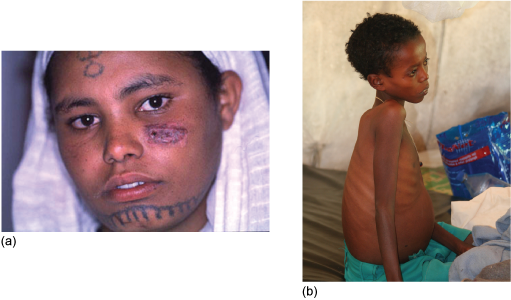1.6 Other infectious disease headlines
Here are some other estimates from the WHO (accessed in 2011).
- Over 350 million people are chronically infected with hepatitis B virus (HBV) and 130–170 million with hepatitis C virus (HCV), causing over 1 million deaths from liver disease and hepatic cancer annually (WHO, 2008, 2011b).
- Excluding HIV and HBV, there are around 350 million new cases of the major sexually transmitted infections, including gonorrhoea, chlamydia and syphilis, which has a disproportionate effect on infants. Approximately 12 million new infections with Treponema pallidum pallidum occur every year, including 1.5 million babies born with congenital syphilis – the most common infection passed from mother to newborn baby. This is more prevalent even than congenital HIV, but far less publicised. In Africa alone, congenital syphilis causes the death of almost 500 000 babies every year (WHO, 2007).
- Around 1.5 billion people are infected with intestinal worms. A typical child in a poor rural environment in a low-income country commonly carries around 1000 hookworms, roundworms and whipworms, causing anaemia, stunted growth and increased vulnerability to other infectious diseases (WHO, 2012a).
- The so-called ‘neglected tropical diseases’ include Schistosoma parasites, which infect 207 million people worldwide – 85% of them in Africa, causing an estimated 200 000 deaths annually. Around 12 million people in 88 countries are chronically infected with Leishmania parasites, which cause severe cutaneous (Figure 4a) or visceral (Figure 4b) disease (WHO, 2012b).

- Around 500 000 people are blinded by the microscopic parasitic worm Onchocerca volvulus (WHO, 2012c) and over 120 million people worldwide are infected with Wuchereria bancrofti, the parasite causing lymphatic filariasis (WHO, 2012d).
- The viral haemorrhagic fevers are epidemic-prone diseases, which are increasing their geographical range and the number of people affected. Annually, it is estimated there are:
- 200 000 cases of yellow fever, causing 30 000 deaths
- 300 000–500 000 cases of Lassa fever, causing 5000 deaths
- up to 50 million dengue virus infections, including at least 250 000 cases of haemorrhagic fever and 24 000 deaths (WHO, 2012e).
With this daunting background in mind, the next section illustrates the diversity of public health approaches to controlling the huge burden of infectious diseases. An additional aim is to demonstrate the importance of addressing local needs and engaging local communities in interventions to improve public health, as you will see particularly in a slidecast on ‘Infectious disease and public health in rural Ethiopia’ in Section 4 (Video 1), and when you read about the guinea worm eradication campaign in Section 5.
